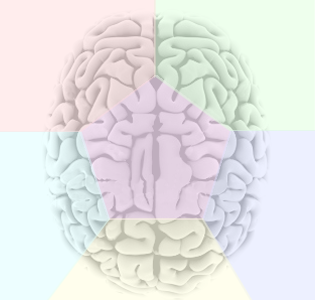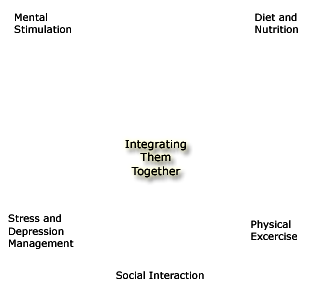Why Nutritional Supplements May Be Essential to Senior Brain Health
You know I have been harping on the importance of good nutrition for senior brain health for many years now. We have long known that seniors tend to test low for a variety of important nutrients. But I never knew for sure why. Recently, however, I received a fascinating article from Dr. John Sijben, Director of research at the Centre for Specialised Nutrition, at Utrecht University in The Netherlands. In 2013 doctor Sijben and an elite team of Alzheimer’s researchers from NY, San Francisco and France, conducted an extensive review of Alzheimer’s research and nutrition. Once again they found a strong link between poor nutrition and Alzheimer’s. In their report they note “many studies have demonstrated that low levels of various nutrients is associated with an increased risk for developing Alzheimer’s disease (AD).”[i]
For example, studies have shown an increased risk following low consumption of specific vitamins including the B vitamins, vitamin C, E and DHA (docosahexaenoic acid). And numerous US Department of Agriculture studies have shown that for various reasons like soil depletion and processing procedures our food is not as nutrient dense is it was 60 years ago.[ii] Low consumption and nutrient depletion, however, are not the only reasons for this malnutrition in seniors. Their study revealed at least five other reasons for these deficits.
First, reduced absorption of nutrients. As we age the absorption of nutrients from the gut into the blood can be compromised. Their primary example of this is “the reduced liberation of food-born vitamin B12” seen with aging. Seniors often lack the stomach acids and intrinsic factors needed to break down meats and other proteins in order to extract the B12 contained therein. This is especially the case if they are taking some type of antacid like Prilosec®, Zantac®, Nexium®, Mylanta®. Maalox, or TUMS. Vitamin B12 is essential to brain health. And a lack of B12 is the most common underlying cause to depression and dementia in seniors. (See How Digestive Health Affects Mental Health.)
Second, reduced production/conversion (synthesis) of specific nutrients within the body. Examples are reduced synthesis of DHA and SAMe in the liver of patients with AD. DHA is synthesized from plants high in linolenic acid like flaxseed, walnuts, and spinach. SAMe comes from folate in plants and B12 in fish and animal products and it can be produced in a healthy gut. And again both DHA and SAMe are essential to brain cell integrity and health.
The Netherlands researchers noted this decline may be attributed to age-related decline in liver function and accelerated loss of liver function in AD, which may also affect our body’s production of other nutrients like the precursor for phospholipid synthesis, uridine monophosphate. These lipids including serine and choline are also essential to brain cell integrity and function. Higher levels of uridine have been shown to improve memory.
Third, alterations in metabolism. Problems in the body’s ability to metabolize sugars and fats are well documented in the development of diabetes, leading to increased fat storage, reduced energy for thinking, and increased amyloid protein damage leading to Alzheimer’s. However, they note other metabolic problems as well. For example, they note B vitamins (B6, B9 & B12) are critical components of one-carbon metabolism essential to maintaining the methylation capacity of cells. If these are lacking, as they often times are in seniors they may have trouble reducing inflammation (homocysteine) in the brain which numerous studies have shown contributes to Alzheimer’s.
Fourth, decreased transportof nutrients into the brain. This is typically referred to as vascular insufficiency and can occur anywhere in the brain. They also specifically note “decreased passage of nutrients through the blood brain barrier (BBB).” This is the special barrier designed to keep toxins from entering our brain. But as we age, it may begin to allow more toxins in, and like the spam filter on your email, it may filter some important items, i.e. nutrients, out. Examples they give of this are age related decreases in choline uptake into the brain and reduced folate transport over the BBB. Choline is the primary building block of memories. Folate is essential for brain cell health and communication.
Finally, increased utilization of nutrients for AD related processes, i.e. protecting and repairing cells. For example they note that “oxidative stress” to brain cells (widely recognized as a contributor to Alzheimer’s) “may lead to an increased use of antioxidant molecules and therefore cause a disease-specific decrease in their circulating levels.” Which, by the way, serves to perpetuate the disease and cognitive decline.
In summary, using layman’s terms, they note “these reductions in absorption, synthesis and transport compromise nutrient availability. This may have important consequences as these nutrients are hypothesized to be critical” in preventing the physically damaging processes of Alzheimer’s disease.
Their Conclusions: “These observations suggest that AD patients may exhibit hidden deficiencies for specific nutrients, even with normal dietary intake and in the absence of malnutrition. Higher intake may therefore be necessary to compensate for the compromised availability of several nutrients, and to meet their requirement in AD.”
For healthy individuals “a future consideration is to investigate nutrient levels and metabolism in presymptomatic AD, when the damaging subclinical changes may not have yet accumulated to an irreversible degree.”
What Nutrients Are Most Needed
A logical question at this point would be, “So what are those nutrients required by our body in order to maintain a healthy brain and avoid Alzheimer’s, which are often lacking in aging Americans?”
Various studies, including this review, have shown that seniors, especially those with Alzheimer’s tend to be critically low in various nutrients, the most common (or most studied) being: vitamins B-12 and folate or folic acid, vitamins C, D and E, the proteins L-carnitine, L-tryptophane, NAC (cysteine), Omega-3 fatty acids, choline, magnesium, selenium, and zinc, endogenous SAMe, uridine, and “likely many more.”[iii]
Unfortunately there are not many tests readily available to the average doctor for assessing these levels. But there are a few for example. Dr. Perlmutter suggests the following and their parameters.
Test Problematic what it suggests
* homocysteine above 8 umol/L lack of folic acid or B12
* vitamin D below 80 ng/ml lack of sunshine or vitamin D3
* C-reactive protein above 3.0 mg/L lack of antioxidants – C, E, NAC
The following tests denote an imbalance in blood sugars which suggest too much sugar or a lack of fiber in the diet, but as a result a person may also lack B vitamins, (especially B1) as well as Omega3 fatty acids, L-carnitine & L-carnosine.
* fasting blood glucose above than 95 mg/dl too much sugar, not enough fiber
* fasting insulin above 8 uIU/ml too much sugar lack of carnitine
* hemoglobin AIC less than 4.8 or < 5.4 percent sugar imbalance
* fructosamine less than 188 or < 223 umol/L sugar imbalance
Here’s a few other observable indicators though less precise.
An inability to sleep suggests a lack of tryptophan and/or magnesium (especially if this is accompanied by muscle cramps).
Agitation suggests a lack of choline, magnesium, folic acid acid, B12, SAMe, and or Omega3’s.
Low energy or depression suggests a lack of B12 and maybe folic acid, SAMe, antioxidants and possibly magnesium and Omega3’s.
Problems with the immune system, repeated colds or congestion suggest a possible lack of Vitamin D, NAC, selenium and zinc.
Memory problems suggest a possible lack of any or all of the above.
What Can We Do To Protect Ourselves?
To be sure you can ask for more specific tests, but as Dr. Laura Paulick points out sometimes it’s less expensive to just try various supplements, and see if you feel better. That way you not only know if you were low, but you’ve already applied the remedy! And it doesn’t cost much more as most of these are not expensive to try, and come in forms that are easier for an older body to assimilate.
By the way, at least 30% of adults have difficulty absorbing regular folic acid or B-12. If you suspect this may be the case with you, then ask for “activated” or “coenzyme” forms of these, or try the Life Extension Complete B supplement, or better yet Perceptiv™ as this contains an enteric coated B12, as well as folic acid, SAMe, NAC, the most readily absorbed forms of L-carnitine (ALCAR) and vitamin E. Accordingly most people who try it note that only do they feel better, but they remember better as well! If you are interested contact me at davidrjl@aol.com and I will explain how you can obtain that or any other supplement at a 30% discount to try.
In short, while good nutrition is essential to brain health, inadequate nutrition is one of, if not the most significant contributors to cognitive decline and Alzheimer’s as we age. So it’s essential that we all pay close attention to their diet, and choose foods high in good nutrition. Ideally in season from local farmers, organic or grow your own.
Additionally, a flood of new related research suggests that the right combination of supplements can be of great value in overcoming these nutritional deficits, reducing risk for decline, and improving cognitive function in those who have already declined including the enhancement of mood, memory, good judgment, special abilities and mental agility.
——–
[i] Lopes da Silva, S, Vellas, B, Elemans, J., et. al. Plasma nutrient status of patients with Alzheimer’s disease: Systematic review and meta-analysis. Alzheimer’s & Dementia 10 (2014) 485–502
[ii] http://www.immunehealthscience.com/cysteine.html
“This is because the nutrient content of food has been reduced due to depleted soils, the use of pesticides and herbicides, processing and pasteurization, wholesale farming techniques that require collection of fruits and vegetables when they are not ripe. In many cases months pass before product reaches the shelves in the supermarket. Most vitamins, in fruits and vegetables, only have a shelf life of up to a few weeks after picking…
As for nutrients, it is well documented that processing/cooking destroys most of them. An example is the bonded cysteine molecule in cow’s milk, which is one of the Glutathione precursors, – heat and mechanical stress break it down making this dietary cysteine source useless for building intracellular Glutathione.”
[iii] Shea, TB, Remington, R, (2012) Nutrition and Dementia: are we asking the right questions? J Alzheimer’s Disease, in press. See also David Perlmutter, M.D. (2004) The Better Brain Book, Riverhead books; and Mark Hyman, M.D. (2009) The Ultra Mind Solution.
Prevention Strategies 








- FREE SPECIAL REPORT AND UPDATES
For free monthly updates on the latest practical research related to brain health and memory improvement, and a free 23 page report on How to Prevent or Arrest Alzheimer's, Click here. Recent Comments
Archives
- July 2019
- November 2018
- September 2018
- July 2018
- June 2018
- April 2018
- February 2018
- January 2018
- December 2017
- October 2017
- September 2017
- August 2017
- June 2017
- May 2017
- March 2017
- January 2017
- December 2016
- October 2016
- September 2016
- August 2016
- June 2016
- May 2016
- April 2016
- March 2016
- February 2016
- January 2016
- December 2015
- November 2015
- August 2015
- July 2015
- June 2015
- May 2015
- April 2015
- March 2015
- February 2015
- January 2015
- November 2014
- October 2014
- September 2014
- August 2014
- July 2014
- June 2014
- April 2014
- March 2014
- February 2014
- January 2014
- December 2013
- November 2013
- October 2013
- September 2013
- August 2013
- July 2013
- June 2013
- June 2012
- February 2012
- January 2012





